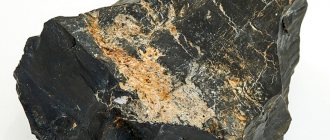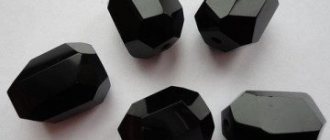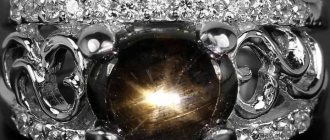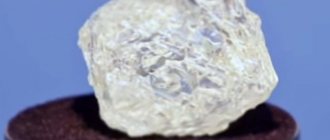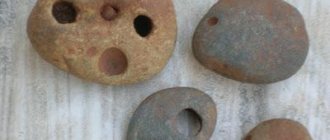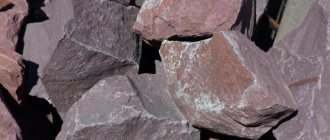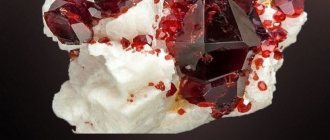- What is the Kaaba?
- Appearance
- Kaaba inside
- Around the Kaaba
- The Mystery of the “Black Stone of the Kaaba” Do Muslims Worship the Black Stone or the Kaaba?
- Reconstruction under Quraish
The Kaaba in Mecca or al-Kaaba is the name of the main shrine of the Muslim world . It is in the direction in which all praying Muslims turn during prayer; this is called turning in the direction of the qibla.
Also, every year Muslims all over the world make a pilgrimage to the Holy Kaaba as part of the Hajj, and this pilgrimage is an important part of the Muslim ritual.
In the Muslim world, it is believed that the Kaaba Stone on earth embodies al-Kaaba in heaven.
The Kaaba is located in ]al-Masjid al-Haram[/anchor], the Forbidden Mosque, which is the main mosque of Saudi Arabia.
Appearance
The Kaaba in Mecca is a building made of stone, which reaches fifteen meters in height and has a base of 12 meters by 10 meters, with its corners of the Kaaba pointing towards the cardinal directions.
Each corner of the holy Kaaba has its own name:
- the eastern corner is called the “black corner” or “ar-rukn al-aswad”, “ar-rukn”. A “black stone” “al-hajar al-aswad” framed in silver is built into the “black corner” at a distance of one and a half meters from the ground. The black stone of the Kaaba is a sign for people, it symbolizes the power of Allah Almighty, and this symbol, as evidence of His strength and power, was sent by Allah Almighty to the earth to humanity. The black stone of the Kaaba consists of three fragments, which are joined together and have a reddish-black tint of color;
- the northern corner is called “ar-rukn al-Iraqi” or “Iraqi”;
- the western corner is called “Syrian” or “ar-rukn ash-shami”;
- the southern corner is called “ar-rukn al-yamani” or southern.
The top of the Kaaba is covered with black cloth or kiswa, which is black cloth sewn together. The verses of the Holy Book of the Koran are embroidered on this canvas, which are located along the border, and are also embroidered inside the medallions. These are the verses of the Holy Book of the Koran that relate to the issues of Hajj and the Kaaba itself.
In the north-eastern wall of the building there is a door, which is also hidden by a blanket. This door is located high above the ground at a height of about two meters. In order to get inside to cleanse the Kaaba or during a visit to it, a special ladder is placed at this door.
LiveInternetLiveInternet
Original: https://mysteryoftheinquity.wordpress.com/2011/04/04/the-black-stone-at-mecca/
(Pictured: Sacred Yoni, part of the Sacred Black Stone, built into one of the corners of the Kaaba in Mecca - a place for pilgrims).
In Mecca the Goddess was Shaybah or Sheva, the Old Woman, she was worshiped as the Goddess of the Scythian Amazons and perhaps the stone was the personification of her image. The Sacred Black Stone, now placed in the Kaaba in Mecca, was her feminine symbol, marked with the sign of the Yoni, and covered, like women in ancient times, in a veil (burqa). No one today seems to know what exactly this stone is. The Black Stone lies in the Haram, "Sanctuary", which is similar to the word "harem", which is used to designate the Temple of Women in Babylon, the Temple of the Goddess Har, the mother of harlots. The Haram's hereditary guardians were initially women, and only later was it handed over to male priests who called themselves Beni Shayban - "Sons of the Old Woman."
So what is this Black Stone of Mecca? Here is a possible answer: The Black Stone is the Omphalos of the Goddess. Bob Trubshaw
(By the way, in the stone in the photo above I see a symbolic image of an embryo. Or it just seems to me. I haven’t yet found information about what kind of angle the stone is and what these “inclusions” mean, which are not in other photographs - Mts.)
Many Omphaloses are associated with stones - be it the Lia Fil (Stone of Destiny) at Tara or various “king stones” (for example Kingston on Thames), where medieval English kings were crowned. But some of these sacred stones have a special interest - they are (or are believed to be) black. Such Black Stones are usually associated with legends that they fell from the stars. Obviously, meteorites upon impact should crumble into small fragments and also leave noticeable craters. In fact, this is not what is important, but the symbolism of such stones, representing the connection between this world and the heavens, is an integral aspect of the Cosmic Axis which is present in all sacred centers.
Perhaps the most famous and revered Black Stone at present is the Ka'bah in Mecca. Ka'bah means "cube" and describes the shape of the marble pedestal on which sits the black stone, located in the center of the Great Mosque, Masjidul Haram, in the center of Mecca. It is about 50 feet high and about 35 meters wide. Set in the eastern corner is a sacred stone covered with elaborately embroidered black draperies. Since any non-Muslim entering the temple will be killed, and photography in the temple is generally prohibited, this stone is surrounded by mystery. However, Rufus Camphausen was able to track down three pilgrimages to Mecca, during two of which photographs were taken (1-3). I was able to see a polished black stone set in a large alloy of pure silver. All together it quite clearly resembles the vulva of a goddess. Muslims now call it the Hand of Allah, perhaps so as not to diminish the desire of all those who make the pilgrimage to Mecca to touch or kiss the sacred object.
(Here I have a remark that it is the silver “frame” of a characteristic shape that makes the shrine look like a vulva. Therefore, it is interesting in what period the stone was placed in this setting. Most likely back at the time when the stone was associated specifically with the feminine principle For wanting to choose a worthy frame for an artifact associated with a male God, such a form is more than a strange choice)) - Mts.)
The black stone has long been broken, and a silver frame holds the fragments together. Traditionally it is believed that it was a meteorite, and the stone was white when it hit Earth and then turned black. The change in color has led to the belief that the stone absorbs the sins of pilgrims, but at the same time, it is consistent with the known phenomenon that meteorites that are initially white oxidize over a period of time. “The main shrine in the Arab religion was stone. . . . Such a stone was considered the seat of God, hence the term applied to it by Byzantine Christian writers of the fifth and sixth centuries: ". Baetyl", from bet'el, "house of God".
In the Arabian north, temples sometimes stood in the open air and could be protected by vaulted niches - Qubbah. Not to be confused with Qubbah, which applies to the Kaaba, and refers to the cubic shape that serves as a shelter for the sacred stones." [5]
An inscription on Adumattu, Arabia, reads: "Allat (Goddess) can use any wish." Another inscription: “Shalm-Allat (the world of the Goddess)” Camphausen in his article shows that hostility towards women in the Muslim religion has its origins in the worship of the goddess. Allah is an updated version of the ancient goddess Al'Lat, and it was her temple that has a continuation - slight changes - the Kaaba.
According to history, Mohammed says he was born around 570 AD. in the Quraish tribe, who not only worshiped the goddess Q're, but were the guardians of her shrine. From 622 AD Mohammed preached the ways of his god, Allah, and as a result was expelled from his own tribe.
Triple Goddess
Pre-Islamic goddess worship appears to be associated primarily with Al'Lat, which simply means "goddess". She is a triple goddess, similar to the Greek moon deities Kore/Demeter/Hecate. Each aspect of this trinity corresponds to the phase of the moon. In relation to Al'Lat there are three ways of identifying these three aspects of the goddess: Q're - crescent or maiden; Al'Uzza - literally "the strong one", who is the full moon, and has a maternal aspect, and then Al'Menat - the waning but wise goddess of fate, prophecy and divination. Islamic tradition continues to recognize this trinity, but now calls them "daughters of Allah."
(By the way, looking at the third woman in this picture, I remember one of my dreams - Mts).
According to Edward Rhys, Al'Uzza was especially revered in Ka'bah, where she belonged to seven priestesses. Her admirers walked around the sacred stone, each seven times - according to the number of seven planets known at that time. The action was performed in the nude. The Zamzam flows next to the Kaaba, quenching the thirst of countless pilgrims.
Water always flows in the oasis; the Black Stone on its mountain has become a symbol of the Goddess who gives life. Only on the Indian continent are they made such physical symbols of male and female generative power - lingas and yonis - and continue to worship them with the original zeal.
It is easy to imagine that in pre-Muslim times the temple of the goddess in Mecca was an outstanding place for the joy of life, requests for protection, prayers for posterity. Legend says that Abraham's wife, unable to have children, brought her slave Hagar to him at this place so that Abraham could make love to her. Later, when Hagar returned to give birth, she could not find water and Abraham created the holy well of Zamzam to save the life of his first son.
When Muhammad wanted to supplant Al'Lut with Allah, it was one temple and Allah had to win. Although Muhammad did conquer the Kaaba, little changed. Worshipers still circumambulate the Holy of Holies seven times (although they now do so while fully clothed). The priests of the shrine are still known as Beni Shaiba or "Sons of the Old Woman - Shaiba", who is now, of course, known as one of the queens of Solomon's time.
Sheba appears under the guise of Lilith in the Middle East and as Hagar (“Egyptian”) in Jewish mythology of the Old Testament. So, having rewritten the above legend, Abraham made his son Ismail - the ancestor of all Arab peoples - on the Black Stone of the Kaaba, which belonged to the goddess.
As long as we trace the name, Q're (or Qure), the first aspect of Al'Lut, the origin of the Greek Kore seems obvious. Camphausen suggested that the Holy Qur'an Koran (qur'an in Arabic) means "The Word of Qure". Even Muslims admit that the Koran existed before the time of Muhammad. Legend says that it was copied from a divine prototype that appeared in the sky at the beginning of time, or from the Mother Book. Al'Uzza is the maternal aspect of Al'Lut, possibly related to the pre-dynastic Egyptian snake goddess Ua Zit [Uadjet], who evolves into Isis.
Field of archo-astronomy
Returning to the geo-significance of the Kaaba, Professor Hawkins states that it is very precisely aligned with two celestial phenomena. These are the cycles of the Moon and the rise of Canopus, the brightest star after Sirius. In the thirteenth century, the Arab Muhammad ibn Abi Bakr al Farisi noted in his manuscripts that the lunar alignment—the crescent—is an ancient symbol of the virgin goddess that still appears in the national flags of many Islamic countries. On some flags (Algeria, Mauritania, Tunisia and Turkey) the crescent moon is accompanied by a star, probably representing Canopus.
Lord of Sirius
The Egyptian city known as Canopus also appears to have had a temple to the Goddess, and as the Greek historian Strabo (64 BC - 23 AD) pointed out, this temple is considered a place known for wild sexual activities. Such references usually refer to temples where prostitution as a sacred ritual or promiscuity was part of the cult. Invariably in such places, shrines depicting the genitals of a god or goddess were revered. Such sacred debauchery continues to be part of the pilgrimage to Mecca, at least for some Muslims.
Persian Shiites were allowed to form temporary "marriages" during the pilgrimage period. All children born as a result were considered divine or as saints - a custom that has parallels throughout the world. In English, surnames such as Goodman, Jackson or Robinson may have been derived from similar sacred unions with the Green Man god, such as Jack o'the Green or Robin Greenwood. It is also possible to assume that the original meaning of the words “godfather” and “godson” has similar origins.
Sacred black stone revered in the Temple of Aphrodite (Paphos, Cyprus). .
Other Black Stones
Gods of other cultures associated with stones include Aphrodite, Cybele, and later Astarte, Diana. The most ancient sculptures of Diana were carved from a black meteorite.
Thoth - crescent symbol
The earliest form of the name Cybele may have been Kubaba or Kumbaba which suggests Humbaba, who was the guardian of the forest in the Epic of Gilgamesh. The origin of Kubaba may have been Kube or Kuba meaning "cube". The earliest form of goddess worship was the veneration of a cubic stone from Neolithic Anatolia.
Additionally, 'Kubaba' could mean an empty vessel, or a cave - which could also be the highest image of the Goddess. The ideograms for Kubab in the Hittite alphabet are a cube, a double-headed axe, a dove, vases and a door or gate - all cbvdjks images of the goddess in Neolithic Europe.
To the Phoenicians she was Astarte, to the Phrygians she was Cybele; Babylonians, Ishtar; Thracians, Bendis; Cretans, Rhea; to the Ephesians, Artemis; for the Canaanites, Atargatis; to the Persians, Anaitida; Cappadocians, MA. But although her names are different, her attributes are the same - she is always the mother, the helper and the helper, and the bestower of fertility.
Among the Phoenicians she was Astarta; among the Phrygians - Cybele, among the Babylonians - Ishtar, among the Thracians - Bendis, among the Cretans - Rhea, among the Ephesians - Artemis, among the Canaanites - Atargatis, among the Persians - Anaitis, among the Cappadocians - Ma. But although her names are different, her attributes are the same - she is always the mother who helps and bestows fertility.
Stone of Cybele?
The stone associated with the worship of Cybele may have originally been in Pessinus but perhaps in Pergamon or Mount Ida. What is certain is that in 204 BC. he was taken to Rome, where Cybele became the “Mother” of the Romans. Ecstatic rituals of her worship were alien to the Roman temperament, but, nevertheless, annual animated processions with a statue of the goddess took place on the streets of the city. Along with Isis, Cybele retained a place at the heart of the empire until the fifth century, when the stone was then lost. Her cult flourished throughout the empire and every city and village remained faithful to the cult of Cybele.
Aphrodite's house was in the city of Paphos in Cyprus. Various authors describe classical rituals that took place in her honor - these included practices that are now known, but are designated by the term "sacred prostitution". In any case, the tilted black stone that was the altar in this Temple is still preserved, even though it is now placed inside the museum.
The tower on Cybele's head is a reminder of the Tower of Babel—a scene from the first great apostasy after the great Flood.
Also in Cyprus there is another place revered by Muslims - the third most important after Mecca and Medina - Hala Sultan Tekke. There is also a black stone there, they say it is a fallen meteorite. The temple is for women - in honor of the aunt and adoptive mother of the Prophet Muhammad. Perhaps, like in Mecca, this temple was originally created in honor of the Goddess. Unfortunately, there is no evidence of this.
To add a little local flavor, many rocks in the British Isles are said to be of meteorite origin. However, whether such stones were ever associated with the cult of the goddess we will never know.
It would take too much time to discuss the extent to which the cult of the Black Stone goddess may be used as references to Solomon's bride in the Song of Songs, what is meant by "black but beautiful" or to study the black images of Apollo, Artemis and Isis that have their direct continuation in the Black Virgin of Europe - the patroness of troubadours, gnostics, alchemists, as well as the current pope. Those who wish to follow such ideas might read the goddess myths, which provide a sane but inspired appreciation of the female deity that has remained with us throughout history.
Kaaba inside
There are three columns inside the Kaaba, and there are also many lamps and lamps inside, which are decorated with enamel painting. Inside the Kaaba they keep dedicatory scrolls of the Holy Book of the Koran.
Between the place where the black stone of the Kaaba is located and the door there is a part of the wall, which is called “al-multazam”. Near this part of the wall, Muslims say a prayer, weak hadiths are transmitted from the Prophet ﷺ that in this place (between the door and the stone) he ﷺ touched the Kaaba with his chest, face and hands and made dua. The same thing is reliably transmitted from some companions, so you can do this. You can say any dua, although a specific dua is transmitted from the companions.
The north-west wall has a gutter that projects from the roof and is finished in gilt. This water drain is called “mizab ar-rahma” or “al-mizab”.
Qibla is that part of the Kaaba that is located between al-mizrab and the western corner of the Kaaba building.
Al-khatim is a semicircular wall located at the north-eastern wall of the Kaaba, with the help of al-khatim the hijr Ismail or al-hijr is fenced off, this is the name of the place where pilgrims do not enter when they go around the Kaaba seven times, performing tawaf during hajj During the time of Ibrahim, al-hijr was part of the Kaaba itself.
Anomalous phenomena
The world knows similar phenomena that science cannot explain: monoliths hanging in the air, flying or screaming blocks of stone. There is evidence that famous buildings, such as the pyramids in Egypt or temples in India, were built using flying stones. They rose into the air not on their own, of course, but due to a certain sound made by the people involved in the construction.
Some will probably exclaim that this is fiction. What about the Lebanese South Stone, which weighs almost 1000 tons? It is impossible to move it from its place with modern technology, and the builders of the temple in the ancient city of Baalbek (Lebanon) were going to use it in the construction of the shrine. They say that he was left lying just a few minutes' walk from the temple. It is unlikely that he could be pulled to the structure using ropes and the strength of slaves, as was always believed.
To believe or not to believe, let everyone decide for themselves! The last modern story in favor of the existence of monoliths floating above the ground takes place in the Indian settlement of Shivapur. There, during daytime prayer, the monks, surrounding an impressively sized stone (62.5 kg), begin to chant a prayer or mantra. Having reached a certain peak of sound in the chant, the monks raise it with just one finger. When the singing stops, the monks quickly jump away as the “hanging” block falls down into its place . But the most important point is the number of singers - there are always 11 people.
Around the Kaaba
In the video above you can see the live broadcast of the Kaaba online.
A path is paved around the Kaaba, and along this path pilgrims ritually circumambulate the sanctuary - this ritual circumambulation is called “tawaf”.
“ Maqam Ibrahim ” is the name of the building located opposite the door to the Kaaba. A stone was laid in this building, and legend says that the prophet Ibrahim stood on this stone when he was rebuilding the Kaaba. On this stone you can see traces of human feet.
Almost opposite the place where the “black stone” is located, there is Zamzam, a sacred spring.
When Prophet Muhammad ﷺ was young, inside the al-Kaaba building in Mecca there was an idol of a deity named Hubala, who was the patron saint of Mecca. Around the Kaaba at that time there were three hundred and sixty idols of various deities who were revered in Arabia in its different regions and lands. The inside walls of the Kaaba were covered, as the legend says, with images of characters from the Gospel and Bible.
Legends about the stone in Mecca
There are many myths and old legends about the black stone in Mecca. Many of them take roots in the stories of the Koran.
It is generally accepted among Muslims that the gem was given to Adam by Allah when he left heaven. According to another version, Adam voluntarily took the pebble with him in order to feel a connection with God in the earthly world.
There are other mystical stories:
- The mineral is a conglomerate of petrified angels, whose task was to serve the Islamic world and protect the Kaaba.
- Initially, the white gem was brought to the temple under construction by the Archangel Gabriel from the nearby mountains. Over time, it acquired a dark shade.
It is generally accepted that the sacred stone has magic and the ability to protect itself from the wicked. Legend has it that a man who once tried to break a gem died right on the spot. But the gem remained safe and sound.
Muslims to this day attach sacred significance to the relics. They are reverent about religious rituals, visiting the Kaaba and interacting with the black stone. This way they manage to feel closer to God.
Watch a video about the features of the famous stone:
The mystery of the "black stone of the Kaaba"
Opposite the “place of Ibrahim” in the corner of the Kaaba is the black stone “ Hajar al-Aswad ”. The “black stone” is nothing more than a white yacht that was brought to earth from Paradise when God gave it to the prophet Adam. But the stone became black because of human vices and sins.
Do Muslims Worship the Black Stone or the Kaaba?
The answer to this question is obvious: Muslims do not worship either the black stone or the Kaaba. The black stone serves only as a starting point for the circumambulation (tawaf) around the Holy House for Hajj rites. The Kaaba also tells Muslims which way to turn to perform prayer.
History of creation
It is unknown when exactly the Kaaba was built, and there are several different points of view, according to one of these points of view, the credit for the construction of the Kaaba belongs to the Prophet Adam, who was the first man on Earth and the creator of the Kaaba.
According to this version, the first building over this stone was built by the prophet Adam himself; according to various sources, it was some kind of structure or tent. But the very first version of al-Kaaba was erected by his son Sif or Shis.
Then the Kaaba was destroyed, and only after Ibrahim’s son Ismail settled in Mecca, Ibrahim received a command from Allah Almighty to restore the foundation on which the Kaaba stood.
The Holy Book of the Koran contains a verse that tells how the Almighty brought Ibrahim to Mecca, and Ibrahim became the first hanif or pious man who rejected the worship of idols that every tribe had, and called for the worship of one God, and also became the first Muslim. It was Prophet Ibrahim, with the help of his son Ismail, who built the building of the Kaaba, and also became the one who established the ritual of pilgrimage to the Kaaba - the Hajj.
An authentic hadith says that the son of the prophet Ibrahim brought him stones, and Ibrahim himself built the walls, and at the very end of the construction, the son of Ibrahim lifted the stone so that his father could stand on it and finish the construction, and the traces of the prophet Ibrahim were imprinted in this stone.
Unexpected results
A certain Englishman, having learned that this was a stone from Paradise, decided to make sure of this. Having learned Arabic, he came to Mecca and, using tweezers, grabbed small particles of stone and gave them for inspection. The test results amazed the Briton. And he said the shahada and accepted Islam. It was reliably established that this stone has no analogues on earth. The British man was not a Muslim, he had no motive to lie in favor of Islam. It is very difficult for a non-Muslim to accept another religion. For an unexpected act there must be very convincing facts, and the Almighty revealed well-founded facts to the inquisitive Englishman and thereby set him on the path of Truth.
Meaning
The Meccan suras of the Holy Book of the Koran mention that Allah Almighty is the Lord of al-Kaaba, which is called “al-bayt al-mamur” or “al-bayt”. In the Holy Book of the Qur'an, believers are called "the people of the Kaaba" or "ahl al-bayt", and the Kaaba itself is called the "ancient House" or "al-bayt al-atiq".
The Kaaba acquired even greater significance for Islam when the Kaaba was declared the qibla in Medina, that is, the direction in which those praying should face during prayer, although until that moment the praying believers had to face the direction of Jerusalem.
It is the Kaaba that deserves credit for the establishment of Islam as an independent and separate religion, having Arabian roots.
The Kaaba has rooms inside and is covered with black silk.
According to the Koran, the Kaaba is considered the first place that was erected for the worship of Allah. Since its construction, the keys to the Islamic shrine have been kept by representatives of the Bani Shaiba family, who are obliged to ensure its proper appearance. During its history, the Kaaba was reconstructed five times, the last time restoration was carried out in 1996.
In the era before the rise of Islam, around this shrine, in addition to the image of the main God of the Arabians, there were three hundred more minor deities. The Kaaba is considered a holy place and Muslims have never allowed quarrels near the shrine. According to legend, the Prophet Mohammed himself founded the first mosque here.
The Kaaba has a marble foundation and its walls are made of granite. The stone is covered with kiswa, which is a special type of black silk. The material is updated every year. This responsibility is assigned to the caretakers from the Bani Shaiba family. The Kaaba has a height of 13.1 meters, a width of 11.03 meters and a length of 12.86 meters. That is, it is not a perfectly flat cube, but rather a parallelepiped.
Cleansing from idols
The Prophet Muhammad ﷺ was faced with the task of cleansing the Kaaba from idols and freeing it from unbelievers. After a treaty was concluded in al-Hudaibiya between the Meccans and Muslims in 628, the latter were given the right to make a pilgrimage to the Kaaba. Led by the Prophet Muhammad ﷺ, the Muslims made a small pilgrimage, which took place in 629, and already in 630 the Muslims occupied Mecca, and then they destroyed all the idols that stood outside the Kaaba. The paintings on the walls were also destroyed.
The companion of the Messenger of Allah ﷺ Abu Bakr in 630 performed the first full-fledged Muslim hajj in the history of Islam, and in connection with such an event, a revelation was sent down to the Prophet ﷺ, which established the rules for performing the hajj. Also in this revelation it was announced that there had been a complete break with the polytheists. This revelation introduced a ban on pagans taking part in the Hajj. The Messenger of Allah ﷺ will also make a pilgrimage in 631, and this pilgrimage was his last.
Virtues of the Kaaba
1. The first established house for the slaves of Allah.
2. Anyone who visits it will receive a great reward. Abu Hurayrah reported: “I heard the Messenger of Allah (peace and blessings be upon him) say: “Whoever performs the Hajj without swearing or sinning will return home clean of sins, just as on the day his mother gave birth to him.” "" (Bukhari, Muslim, Nasai).
3. Seven circles (tawaf) around the Kaaba is equivalent to the liberation of a slave. Allah is proud of those who perform tawaf before the angels and forgives their sins.
4. Whoever looks at it receives reward, the hadith says: “If one looks at the Kaaba with faith in Allah and conviction of the truth, then his previous and subsequent sins will be washed away, and on the Day of Judgment he will stand with people in safety.” .
5. «Every day 120 mercies are sent down to the Kaaba: 60 of them are for those who perform tawaf, 40 for those who worship there.” And another legend says: “40 for those who pray there, 20 for those who look at the Kaaba” (Tabarani).
6. It was built by two prophets - Ibrahim and Ismail (peace be upon them).
7. The angels made tawaf around this house. The Prophet (peace and blessings be upon him) said:
“When Adam (peace be upon him) completed the rituals of Hajj, angels met him. “O Adam,” they said, “may your pilgrimage be accepted. We made a pilgrimage to this house two thousand years before you."
Reconstructions
Today, the Kaaba in Mecca, the repository of the “black stone”, is the most important center of the Islamic world, a shrine and a symbol of unity for the entire Muslim world. All currents of the Islamic religion recognize the special role of the Kaaba temple and its holiness.
Reconstructions around the Kaaba building were carried out both during the life of the Prophet Muhammad ﷺ, and throughout the subsequent history of Islam, the area around the Kaaba was reconstructed and the mosque at the Kaaba was expanded.
The Kaaba was rebuilt according to different versions from five to twelve times throughout its existence: the reasons for its destruction were fires, floods, and military actions. The tribes that lived in Mecca took care of the Kaaba in turn. During its existence, the Kaaba repeatedly fell into disrepair and was damaged by flood waters.
Reconstruction under Quraish
At the very beginning of the sixth century, the tribe of Quraysh, from which the Messenger of Allah ﷺ himself came, carried out repairs to the Kaaba. The repair work was supervised by a master from Byzantium, who ended up in Mecca by chance, having been in a shipwreck in the Red Sea.
There is a hadith that says that the Messenger of Allah ﷺ at the age of twenty-five took part in the renovation of the Kaaba. During the time of the Prophet Muhammad ﷺ, even before the start of his prophetic mission, the most famous of the reconstructions of the Kaaba was carried out, and it was the Prophet Muhammad ﷺ, having made the right decision, who managed to save the Arab tribes from bloodshed. When a dispute broke out about who should insert the “black stone” into the wall of the Kaaba after reconstruction, it was decided that Muhammad ﷺ should do this, but the dispute did not subside, since now the elders decided to find out who had the right to carry this stone to the Kaaba. And then the Prophet Muhammad ﷺ proposed an unexpected solution: he suggested putting a stone on the cloak, and the elders carry it together, holding the ends of the cloak.
The reconstruction of the temple under the Prophet Muhammad ﷺ is also known for the fact that during this reconstruction the shape of the Kaaba, which until that moment had been rectangular, changed to a square shape. It is also noteworthy that the Quraish did not agree to use money that was earned dishonestly, that is, through gambling or robbery, as well as through prostitution and usury, to pay for reconstruction work and materials for the temple. However, in the process of collecting funds, it was found that people had become so sinful and mired in money-grubbing that it was impossible to raise the required amount only with “pure” money. As a result of a lack of funds, the building of the shrine was shortened, which is why it acquired a square shape. After this, attempts were made more than once to return the Kaaba to its rectangular shape, but in the end the building remained cubic.
Reconstruction after the era of the Prophet ﷺ – Abdullah ibn az-Zubayr
In the thirties of the seventh century, when Caliph Umar was at the head of the caliphate, the houses that were located next to the Kaaba were destroyed, and instead of them, a mosque was built in this place, which was called the Forbidden Mosque or al-Masjid al-Haram.
After Mecca was shelled by Umayyad troops in 683, who fought against Abdullah ibn al-Zubayr, who declared himself caliph, Abdullah declared that he would continue the plan of the Messenger of Allah ﷺ and carry it out, rebuild the Kaaba in order to return the shrine to its ancient appearance, which the temple had under Ibrahim. Then the Kaaba building was expanded, and al-Hijr was also included in its composition.
After Ibn al-Zubayr was defeated in 693, the shrine regained its former appearance and which remains to this day.
Historical events related to the Kaaba
When Mecca was captured in 929 by the Qarmatians, who represented a major religious and political doctrine in the caliphate of the late ninth to early tenth centuries during the reign of the Abbasids, they took the “black stone” with them, and only twenty years later they managed to return the “black stone” to its rightful place .
Over time, the area around the temple was built up with a variety of buildings, which included the departments of the main madhhabs of Islam. These pulpits were removed when the Saudi rulers carried out major renovations to the temple in the fifties and sixties.
A group of Muslim extremists captured the shrine in 1980, extremists seized not only the temple, but also the Meccan mosque. These extremists declared that the Mahdi had appeared in the world, who was named Abdullah al-Qahtani. Two weeks later, the Mosque was stormed, and the militants themselves were destroyed.
Theft of the Millennium
Today the black stone is set in a silver frame. Previously, it was solid and solid and there was no need for this support. Kurmutid sectarians split the black stone during the theft.
The Kurmutids, considered an offshoot of the Ismaili sect, formed a state in the lands of Bahrain under the leadership of Abu Said Hassan bin Abhram al-Jannabi. In 923 (310 AH) power passed to his brother Abu Tahir al-Jannabi. Under him, the sectarian state began to expand and conquer territories of neighboring countries.
They wanted to win the Hajj. Abu Tahir al-Jannabi wanted to make Masjid ad-Dirar, the capital's mosque, a center of pilgrimage.
The sectarians attacked the columns of the Hadjis going to Yathrib, robbed them and drove them into slavery. But there were no fewer people wishing to perform the Hajj. And the leader of the sectarians in 930 (318 AH) decided to conquer the Kaaba and appropriate the Black Stone.
Kidnapping
The Meccans did not want to let Abu Tahir al-Jannabi and the sectarians who arrived with him into the city, but their leader swore that he came in peace. And on the very first day of the hajj he broke his oath. The Karmatians attacked the city, broke into the Forbidden Mosque, and carried out a massacre in the Holy Mosque. Killed 30,000 Muslims! They killed with mockery, reading the lines of the Koran. The Kaaba was looted and destroyed. The sectarians pulled out the Black Stone, broke it into pieces and took it away. The killed Hadjis were thrown into the Zamzam well, thereby desecrating another shrine. The entire territory of the Holy Mosque and the surrounding area was covered in blood. The houses of the Meccans were destroyed and plundered, and the townspeople were driven into slavery.
The leader of the sectarians installed pieces of the Black Stone in the main mosque of the capital.
The leader's terrible end
The capital of the Qarmatians did not become the center of the Islamic world, because the Muslim shrine is protected by the Almighty Himself. The leader of the Qarmatians, Abu Tahir al-Jannabi, suffered a severe punishment - parasites appeared in his body, which slowly devoured his flesh. He died in terrible agony as a warning to others.
Rules for visiting the Kaaba
Since the number of pilgrims is huge and the temple building is very small, visiting the temple itself is impossible, so only special people can enter and stay inside the Kaaba, but for them the doors of the Kaaba are opened only twice a year. These people can see the shrine from the inside only during the ablution ceremonies that take place before the Hajj and before the start of the holy month of Ramadan. Pilgrims performing Hajj can touch the shrine, but visiting the temple is only possible for Muslims, and representatives of other religions cannot enter these holy places.
Black stone embedded in the walls of the Kaaba may be a meteorite
You can get inside the building if you go through a strong door made of yew wood, but not everyone gets the opportunity to enter the holy of holies. No windows or lighting fixtures can be found inside the room, so a mysterious twilight always reigns there.
The interior of the Kaaba is represented by three columns, between which there is a table for incense. The walls are decorated with the names of those politicians and public figures who helped restore the shrine at different times. The interior is topped with green silk. There is also a wooden staircase in the room leading to the roof of the building.
Legends say that inside the Kaaba there is a certain “black stone”. At the site of the construction of the shrine, there really was once a huge red-black stone. Now a small piece of this stone, placed in a silver frame, is embedded in the eastern corner of the Kaaba at a height of one and a half meters. The exact origin of the black stone is unknown, but hadiths believe that everyone who touches it receives God's blessing.
Subject:
- Islam
- Muslims

